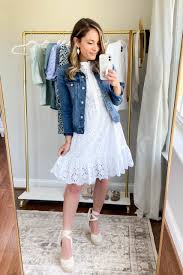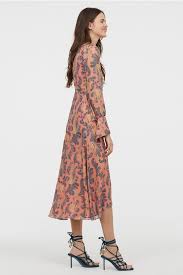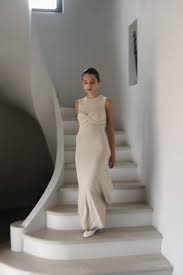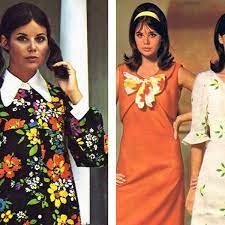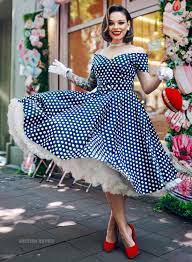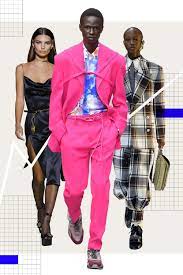The 1950s was a decade that exuded elegance, grace, and femininity in fashion. One iconic style that emerged during this time was the 50s style dress. These dresses have stood the test of time and continue to be a beloved choice for women who appreciate classic fashion.
The hallmark of 50s style dresses is their flattering silhouette. They typically feature a fitted bodice with a cinched waistline and a flared skirt that falls below the knee. This design accentuates the natural curves of a woman’s body, creating an hourglass figure that is both timeless and alluring.
One popular variation of the 50s style dress is the swing dress. This dress is characterized by its full circle skirt that swings and sways as you move, giving it a playful and feminine touch. The swing dress is perfect for twirling on the dance floor or adding a touch of vintage charm to your everyday wardrobe.
Another iconic style from this era is the shirtwaist dress. Inspired by men’s shirts, these dresses feature a button-down front and collars, giving them a sophisticated yet casual look. Shirtwaist dresses are versatile and can be dressed up or down depending on the occasion.
Polka dots, floral prints, gingham patterns, and bold colors were all popular choices for 50s style dresses. These prints added vibrancy and personality to the garments, making them eye-catching and fun to wear. Pairing these dresses with accessories such as gloves, pearls, and cat-eye sunglasses completes the retro look.
The enduring appeal of 50s style dresses lies not only in their aesthetic appeal but also in their ability to make women feel confident and beautiful. The cinched waistline emphasizes femininity while the flared skirt adds movement and grace to every step. It’s no wonder that these dresses have become synonymous with timeless elegance.
Today, many fashion designers draw inspiration from this iconic era, creating modern interpretations of 50s style dresses. Whether you’re attending a special event, looking for a unique wedding dress, or simply want to add a touch of vintage flair to your wardrobe, the 50s style dress offers a perfect choice.
In conclusion, 50s style dresses are a testament to the enduring allure of classic fashion. With their flattering silhouettes and timeless charm, these dresses continue to captivate women of all ages. Embracing the elegance and femininity of the 1950s has never been easier with these beautiful garments that allow us to step back in time while still staying relevant in the modern world.
Timeless Elegance: Embracing the 6 Pros of 50s Style Dresses
- They are very flattering and feminine, creating a timeless look.
- The fabric is usually of high quality, making them durable and comfortable to wear.
- They come in a variety of colours, patterns and styles to suit any occasion or body shape.
- 50s style dresses are often made from natural fabrics such as cotton, silk and linen which are breathable and comfortable to wear even on hot days.
- They can be easily accessorised with jewellery, scarves or hats to create individual looks for each occasion.
- The classic cut of the dress is designed to flatter the figure and provide an elegant silhouette that will never go out of fashion
7 Drawbacks of 1950s Style Dresses: Uncomfortable Fit, Limited Mobility, Heavy Fabrics, Not for Everyone’s Taste, Rarity and Cost, Overpowering Prints, Lack of Pockets
- They can be very uncomfortable to wear due to the restrictive nature of the waist and bust lines.
- They often feature a full skirt, which can make them difficult to move in or dance in.
- The fabrics used are often quite heavy and not as breathable as modern fabrics, making them hot and uncomfortable in warm weather.
- The classic 50s style is generally very feminine, so may not suit everyone’s tastes or body shape.
- As they are vintage items, they may be hard to find and expensive when you do locate one that fits you well.
- Many of these dresses feature large prints which can be overpowering on smaller frames or delicate features such as petite shoulders or arms.
- The lack of pockets on many 50s style dresses makes them impractical for everyday use unless you carry a bag with you at all times
They are very flattering and feminine, creating a timeless look.
One of the undeniable pros of 50s style dresses is their ability to flatter and enhance a woman’s figure, while exuding a timeless sense of femininity. These dresses are designed with a keen understanding of the female form, accentuating the waistline and creating an hourglass silhouette that has been celebrated for decades.
The fitted bodice and cinched waistline of 50s style dresses work together to highlight the natural curves of a woman’s body. By emphasizing the waist, these dresses create an illusion of a smaller midsection, giving the wearer an instantly flattering and feminine shape. This classic silhouette has stood the test of time and remains as appealing today as it was in the 1950s.
Moreover, 50s style dresses offer a timeless look that transcends trends and fads. The elegance and femininity they exude are not bound by time, making them a versatile choice for various occasions. Whether it’s a formal event, a casual outing, or even just adding some vintage charm to your everyday wardrobe, these dresses effortlessly bring about an air of sophistication and grace.
The enduring appeal of 50s style dresses lies in their ability to make women feel confident and beautiful. They celebrate the female form in all its glory, allowing women to embrace their curves and showcase their unique beauty. By wearing these dresses, women can channel their inner retro goddess while staying true to their personal sense of style.
In conclusion, the flattering nature and timeless appeal of 50s style dresses make them a beloved choice for women who appreciate classic fashion. With their ability to enhance femininity and create an hourglass figure, these dresses have become synonymous with confidence and elegance. Whether you’re attending a special occasion or simply want to add some vintage flair to your wardrobe, 50s style dresses offer a flattering and timeless look that never goes out of style.
The fabric is usually of high quality, making them durable and comfortable to wear.
One of the many advantages of 50s style dresses is their exceptional quality of fabric. These dresses were crafted with meticulous attention to detail, using high-quality materials that have stood the test of time.
The durability of the fabric used in 50s style dresses is a testament to their longevity. Unlike some contemporary garments that may wear out or lose shape after just a few wears, these dresses were built to last. The sturdy construction and quality fabrics ensure that they can withstand frequent wear and washing without losing their original charm.
Moreover, the high-quality fabric enhances the comfort factor of these dresses. Soft and breathable materials were often chosen to ensure that women felt comfortable while wearing them throughout the day. Whether it’s a cotton blend, silk, or satin, these fabrics allow for ease of movement and keep you feeling at ease even during warmer weather.
The combination of durability and comfort makes 50s style dresses a practical choice for any occasion. Whether you’re attending a formal event or simply going about your daily routine, you can rely on these dresses to provide both style and comfort.
Additionally, the high-quality fabric contributes to the overall aesthetic appeal of 50s style dresses. It adds an element of luxury and sophistication, elevating their timeless elegance. The smooth drape and rich texture of these fabrics enhance the visual impact and make them truly stand out in any crowd.
In today’s fast-paced fashion world, where trends come and go quickly, investing in a well-made 50s style dress with superior fabric quality is like owning a piece of fashion history. Not only will it remain stylish for years to come, but it will also retain its shape and overall integrity.
In conclusion, one cannot overlook the significant advantage that comes with 50s style dresses: their exceptional quality fabric. The durability ensures they can be cherished for years while still maintaining their original beauty. Moreover, the comfort provided by these garments allows women to feel confident and at ease in any setting. So, whether you’re seeking a timeless wardrobe staple or looking to embrace the elegance of the past, 50s style dresses with their high-quality fabric are an excellent choice.
They come in a variety of colours, patterns and styles to suit any occasion or body shape.
One of the many advantages of 50s style dresses is their incredible versatility. These dresses come in a wide range of colours, patterns, and styles, making them suitable for any occasion or body shape.
When it comes to colours, you’ll find an abundance of options to suit your personal taste and style. From vibrant reds and blues to soft pastels and classic neutrals, there is a colour palette for everyone. Whether you want to make a bold statement or exude subtle elegance, 50s style dresses have got you covered.
Patterns are another fantastic aspect of these dresses. Polka dots, floral prints, gingham checks, and stripes are just a few examples of the patterns commonly found in 50s style dresses. These playful and eye-catching designs add personality and charm to the garments, allowing you to express your unique sense of style.
Furthermore, 50s style dresses cater to different body shapes. The fitted bodice with a cinched waistline creates an hourglass figure that flatters various body types. Whether you have an apple-shaped figure or an hourglass silhouette already, these dresses accentuate your curves in all the right places.
Moreover, there are different styles within the realm of 50s fashion that cater to individual preferences. Swing dresses with their full circle skirts offer a playful and feminine look that is perfect for dancing or casual outings. Shirtwaist dresses give off a more sophisticated vibe with their button-down front and collars.
No matter the occasion – be it a wedding, party, or even just a day at the office – there is a 50s style dress that suits it perfectly. With such variety in colours, patterns, and styles available, you can effortlessly find the ideal dress to match your mood and event.
In summary, one major advantage of 50s style dresses is their ability to cater to different tastes and body shapes. With an array of colours ranging from bold to subtle, patterns that add character and charm, and various styles to choose from, these dresses truly offer something for everyone. Embrace the versatility of 50s style dresses and discover the joy of dressing up in a garment that not only makes you look fabulous but also boosts your confidence for any occasion.
50s style dresses are often made from natural fabrics such as cotton, silk and linen which are breathable and comfortable to wear even on hot days.
One of the many advantages of 50s style dresses is their choice of natural fabrics. These dresses are often crafted from materials like cotton, silk, and linen, which offer a range of benefits, especially when it comes to comfort.
Breathability is a key feature of these natural fabrics. Cotton, for instance, is known for its ability to allow air to circulate freely through the fabric, keeping you cool and preventing excessive sweating on hot days. This makes 50s style dresses an excellent choice for summer or warmer climates where staying comfortable and fresh is essential.
Silk is another fabric commonly used in 50s style dresses. It has a luxurious feel against the skin and offers excellent breathability as well. Silk can help regulate body temperature by wicking away moisture and allowing air to flow, making it suitable for both warm and cooler days.
Linen, a popular choice during the 1950s, remains a sought-after fabric today due to its lightweight nature and breathability. It allows heat to escape from the body while absorbing moisture without feeling damp or heavy. Linen 50s style dresses are perfect for those who want to stay cool while maintaining an effortlessly chic look.
The use of natural fabrics in 50s style dresses not only ensures comfort but also contributes to their durability. These materials tend to be more resilient than synthetic alternatives, allowing your dress to withstand regular wear and washing without losing its shape or quality.
In addition to their practical benefits, 50s style dresses made from natural fabrics exude a certain timeless elegance. The way they drape and move adds an extra touch of sophistication that cannot be replicated with synthetic materials.
So whether you’re attending a summer garden party or simply want a comfortable yet stylish outfit for everyday wear, choosing a 50s style dress made from natural fabrics such as cotton, silk, or linen ensures that you’ll stay cool and comfortable while looking effortlessly chic. Embrace the breathability and comfort of these fabrics, and enjoy the classic beauty of 50s style dresses in any season.
They can be easily accessorised with jewellery, scarves or hats to create individual looks for each occasion.
One of the many advantages of 50s style dresses is their versatility when it comes to accessorizing. These timeless garments provide a perfect canvas for expressing your personal style and creating unique looks for any occasion.
Whether you’re attending a formal event or going for a casual outing, 50s style dresses can be effortlessly transformed with the right accessories. Adding jewellery, such as statement earrings or a delicate necklace, can elevate the dress and add an extra touch of glamour. Vintage-inspired accessories, like brooches or pearl bracelets, can also enhance the retro charm of the outfit.
Scarves are another fantastic accessory that can completely change the look of a 50s style dress. You can tie a colorful silk scarf around your neck for a sophisticated touch or wrap it around your head for a playful and retro vibe. Scarves offer endless possibilities for experimentation and allow you to create different looks with just one dress.
Hats are yet another accessory that pairs beautifully with 50s style dresses. A wide-brimmed hat adds an air of elegance and sophistication, while a cute pillbox hat exudes vintage charm. Hats not only provide protection from the sun but also serve as statement pieces that complete your outfit.
The beauty of accessorizing 50s style dresses is that you can mix and match different pieces to create countless individual looks. Whether you prefer a classic and refined ensemble or want to experiment with bold colors and patterns, there are no limits to how you can express yourself through accessories.
Moreover, accessorizing allows you to adapt your 50s style dress to various occasions. By simply changing your accessories, you can seamlessly transition from day to night or from casual to formal events. This versatility makes these dresses a practical choice for those who want flexibility in their wardrobe.
In conclusion, one of the standout advantages of 50s style dresses is their ability to be easily accessorized. By adding jewellery, scarves, hats, or other personal touches, you can create individual looks that reflect your style and suit any occasion. Embrace the opportunity to express yourself and have fun experimenting with different accessories to make your 50s style dress truly your own.
One of the undeniable advantages of 50s style dresses is their classic cut, which is specifically designed to flatter the figure and create an elegant silhouette. This timeless design element ensures that these dresses will never go out of fashion.
The cut of a 50s style dress typically features a fitted bodice that accentuates the waistline, creating a desirable hourglass shape. This tailored approach highlights the natural curves of a woman’s body, enhancing her femininity and confidence. Whether you have a petite frame or more voluptuous curves, the classic cut of these dresses adapts to various body types, making them universally flattering.
The emphasis on the waistline in 50s style dresses creates an illusion of a smaller waist, giving the wearer a graceful and elongated look. This design feature not only enhances one’s appearance but also boosts self-assurance by highlighting their best assets.
Moreover, the elegant silhouette achieved by this classic cut has proven its longevity over time. Despite evolving fashion trends, 50s style dresses have remained relevant and sought after throughout the years. Their timeless appeal transcends passing fads, making them a reliable choice for any occasion.
Whether it’s for a formal event or a casual outing, these dresses exude sophistication and charm. Their ability to effortlessly combine elegance with versatility makes them an essential wardrobe staple for those who appreciate enduring style.
In conclusion, the classic cut of 50s style dresses offers numerous benefits that contribute to their everlasting popularity. By accentuating and flattering the figure, they provide an elegant silhouette that withstands changing fashion trends. Investing in these timeless pieces ensures that you’ll always have an outfit option that exudes confidence and showcases your unique beauty.
They can be very uncomfortable to wear due to the restrictive nature of the waist and bust lines.
While 50s style dresses are undeniably charming and elegant, one con that should be considered is their potential discomfort due to the restrictive nature of the waist and bust lines. These dresses were designed to accentuate the hourglass figure, often featuring a cinched waistline and fitted bodice.
The emphasis on a small waist can sometimes lead to discomfort, especially for those who prefer looser or more relaxed clothing. The tightness around the waist can restrict movement and make it challenging to engage in activities that require more flexibility.
Similarly, the fitted bust line of 50s style dresses may not be suitable for everyone. Women with larger busts may find these dresses uncomfortable or even constricting. It’s important to prioritize comfort when choosing clothing, as feeling at ease in what you wear contributes significantly to your overall confidence and enjoyment.
However, it’s worth noting that not all 50s style dresses are equally restrictive. Some modern designers have made adaptations to improve comfort without compromising the vintage aesthetic. Look for dresses with stretchy fabrics or adjustable features such as elasticized waists or corset-style lacing at the back.
Additionally, choosing the right size and fit is crucial when considering a 50s style dress. Sizing can vary across brands, so it’s essential to consult size charts and reviews before making a purchase. Taking accurate measurements of your body and comparing them with size guidelines will help you find a dress that fits comfortably.
In conclusion, while 50s style dresses possess undeniable charm and timeless appeal, their restrictive nature around the waist and bust lines can pose challenges in terms of comfort. However, with careful consideration of fabric choices, adjustable features, and proper sizing, it is possible to find a 50s style dress that strikes a balance between elegance and comfort – allowing you to embrace retro fashion without sacrificing your well-being.
They often feature a full skirt, which can make them difficult to move in or dance in.
While 50s style dresses are undoubtedly beautiful and exude a sense of timeless elegance, it’s important to acknowledge that they do come with a con: the full skirt. The characteristic flared skirt, while adding an enchanting touch to the overall look, can sometimes make these dresses a bit challenging to move in or dance in.
The voluminous nature of the skirt restricts the range of motion, particularly when it comes to activities that require swift and unrestricted movement. Whether you’re hitting the dance floor or simply navigating through a crowded room, the fullness of the skirt can pose some difficulties.
However, it’s worth noting that not all 50s style dresses have an extremely full skirt. Some variations, like pencil or wiggle dresses, offer a more streamlined silhouette that allows for easier movement. These styles are often preferred by those who want to enjoy the vintage aesthetic without sacrificing comfort or practicality.
Additionally, there are ways to mitigate this con if you still wish to wear a dress with a full skirt. Choosing fabrics with more drape and less stiffness can help improve mobility. Opting for shorter lengths or tea-length styles can also make it easier to navigate while maintaining the retro charm.
Ultimately, it’s important to consider your personal preferences and the specific occasion when deciding on a 50s style dress. If dancing or ease of movement is a priority for you, exploring alternative silhouettes within the era’s fashion repertoire might be a wise choice.
Despite this minor drawback, 50s style dresses continue to be adored by fashion enthusiasts worldwide. Their timeless appeal and feminine allure make them an enduring choice for those seeking classic elegance in their wardrobe. So go ahead and embrace these stunning garments while keeping in mind your own comfort and mobility needs.
The fabrics used are often quite heavy and not as breathable as modern fabrics, making them hot and uncomfortable in warm weather.
While 50s style dresses are undeniably charming and elegant, there is one drawback that some may find inconvenient: the choice of fabrics. In comparison to modern fabrics, the materials used for 50s style dresses tend to be heavier and less breathable, making them less suitable for warm weather.
During the 1950s, natural fibers like cotton, wool, and rayon were commonly used in clothing manufacturing. While these fabrics have their own merits in terms of durability and structure, they can be less forgiving when it comes to breathability. In warmer climates or during hot summer days, wearing a 50s style dress made from these materials can lead to discomfort due to trapped heat and limited airflow.
However, it’s important to note that advancements in fabric technology have allowed for the creation of modern replicas or adaptations of 50s style dresses using lighter and more breathable materials. Many contemporary designers now offer options made from lightweight cotton blends or synthetic fabrics that mimic the look of vintage dresses while providing improved comfort.
For those who still prefer authentic vintage pieces or replicas made with original fabrics, there are a few tips to mitigate the heat issue. Opting for lighter colors can help reflect sunlight and keep you cooler. Additionally, choosing dresses with shorter sleeves or sleeveless designs can also alleviate some discomfort by allowing better air circulation.
Ultimately, while the heaviness and lack of breathability may be a con for some individuals when it comes to 50s style dresses, it’s worth considering that fashion choices often involve trade-offs. The timeless elegance and unique aesthetic appeal offered by these dresses continue to attract enthusiasts who are willing to endure a bit of warmth in exchange for capturing the spirit of a bygone era.
The classic 50s style is generally very feminine, so may not suit everyone’s tastes or body shape.
While 50s style dresses are often celebrated for their timeless elegance and feminine charm, it’s important to acknowledge that this aesthetic may not suit everyone’s tastes or body shape. The classic 50s silhouette, with its fitted bodice and flared skirt, is designed to accentuate curves and create an hourglass figure. However, individuals with different body types or personal style preferences may find this look less appealing or flattering.
Fashion is a form of self-expression, and it’s crucial to embrace styles that make us feel confident and comfortable in our own skin. While some may adore the vintage allure of 50s style dresses, others may prefer more contemporary or minimalist designs. It’s all about finding what suits you best and allows you to express your unique personality.
Moreover, body shapes vary greatly among individuals, and what looks stunning on one person may not have the same effect on another. While the cinched waistline of a 50s style dress can accentuate curves beautifully, it might not be as flattering for those with different body proportions or who prefer looser-fitting garments.
Fortunately, fashion offers a vast array of choices beyond the 50s style dress. There are countless other silhouettes, cuts, and designs available that cater to diverse tastes and body shapes. From sleek sheath dresses to flowy maxi dresses and everything in between, there is something for everyone.
Ultimately, the beauty of fashion lies in its ability to empower individuals to express themselves authentically. If the classic 50s style doesn’t resonate with your personal taste or flatter your body shape as desired, remember that there are countless other options out there waiting to be explored. Embrace what makes you feel confident and beautiful because true style is about finding what works best for you.
As they are vintage items, they may be hard to find and expensive when you do locate one that fits you well.
While 50s style dresses have an undeniable charm and timeless appeal, there is one downside to consider: their vintage nature can make them challenging to find and potentially expensive when you do come across one that fits you perfectly.
Due to their age and limited availability, locating a genuine 50s style dress in good condition can be quite a treasure hunt. Vintage stores, online marketplaces, and specialty boutiques may be your best bet for finding these nostalgic garments. However, the search may require time, effort, and patience.
Additionally, the scarcity of these dresses often translates into higher price tags. As collectors and enthusiasts value their rarity, vintage 50s style dresses can come with a significant price premium. This factor may limit access for those on a tight budget or looking for more affordable options.
However, it’s important to note that not all hope is lost. Many contemporary fashion brands draw inspiration from the 50s era and create modern reproductions of these iconic dresses. These reproductions offer a similar aesthetic but are more accessible in terms of availability and affordability.
Ultimately, while the challenge of finding a well-fitting vintage 50s style dress at an affordable price is worth considering, it shouldn’t discourage you from exploring this elegant fashion trend. Whether you choose to invest in an authentic vintage piece or opt for a modern reproduction, embracing the timeless allure of 50s style dresses can add a touch of nostalgia and sophistication to your wardrobe.
Many of these dresses feature large prints which can be overpowering on smaller frames or delicate features such as petite shoulders or arms.
While 50s style dresses are undeniably charming and iconic, it’s important to acknowledge that they may not be suitable for everyone. One con to consider is that many of these dresses feature large prints, which can be overpowering on smaller frames or delicate features such as petite shoulders or arms.
The bold and vibrant prints that were popular during the 1950s can sometimes visually overwhelm those with more petite or delicate proportions. The larger patterns can make a person appear smaller or drown out their natural features, which may not be the desired effect.
For individuals with smaller frames, it may be more flattering to opt for dresses with smaller or more subtle prints. This allows the dress to complement their figure without overpowering it. Additionally, choosing solid colors or dresses with smaller patterns can help create a more balanced and proportionate look.
It’s important to remember that fashion should enhance and flatter an individual’s unique features and body type. While 50s style dresses are undoubtedly beautiful, it’s essential to consider how they will interact with your specific physique before making a purchase.
Fortunately, there are various styles within the realm of 50s fashion that cater to different body types and personal preferences. A-line dresses, for example, offer a classic silhouette without relying heavily on bold prints. Alternatively, opting for solid-colored dresses with carefully placed details can also provide a sophisticated and flattering look.
Ultimately, fashion is about finding what makes you feel confident and comfortable in your own skin. If large prints on 50s style dresses don’t suit your frame or personal aesthetic, there are always alternative options available that will allow you to embrace the timeless elegance of this era while staying true to your individual style.
The lack of pockets on many 50s style dresses makes them impractical for everyday use unless you carry a bag with you at all times
While 50s style dresses are renowned for their timeless elegance and feminine charm, there is one notable drawback that often goes unnoticed – the lack of pockets. Many 50s style dresses were designed without functional pockets, making them somewhat impractical for everyday use unless you have a bag or purse with you at all times.
In an era where convenience and functionality are highly valued, the absence of pockets in these dresses can be frustrating for modern women. Pockets serve as a practical solution for carrying small essentials like keys, phones, or lip balm without the need for an additional accessory. They provide a sense of freedom and ease, allowing one to go about their day with everything they need within arm’s reach.
The absence of pockets in 50s style dresses can be attributed to the fashion trends and societal norms of that time. The emphasis was on creating a streamlined silhouette and accentuating the waistline, which often meant sacrificing practicality. Women would typically carry small purses or handbags to accommodate their belongings.
However, it is worth noting that not all 50s style dresses lack pockets. Some modern designers have recognized this inconvenience and incorporated functional pockets into their designs while maintaining the classic aesthetic. These updated versions offer the best of both worlds – the timeless elegance of the 50s style dress with the convenience of modern-day functionality.
For those who adore authentic vintage pieces or prefer not to carry an extra bag, there are workarounds available. Some women opt for wearing a belt bag or attaching a small pocket accessory to their dress, providing a stylish solution to the pocket conundrum.
Ultimately, when considering whether to invest in a 50s style dress, it’s essential to weigh its stunning aesthetic appeal against its practicality for your lifestyle. While they may not be ideal for everyday use without additional storage options, these dresses still hold immense value as statement pieces for special occasions or when embracing retro-inspired fashion.
In conclusion, the lack of pockets on many 50s style dresses can pose a practical challenge for those seeking convenience in their daily lives. However, with modern adaptations and creative solutions available, it is possible to enjoy the timeless elegance of these dresses while still accommodating your everyday needs.
